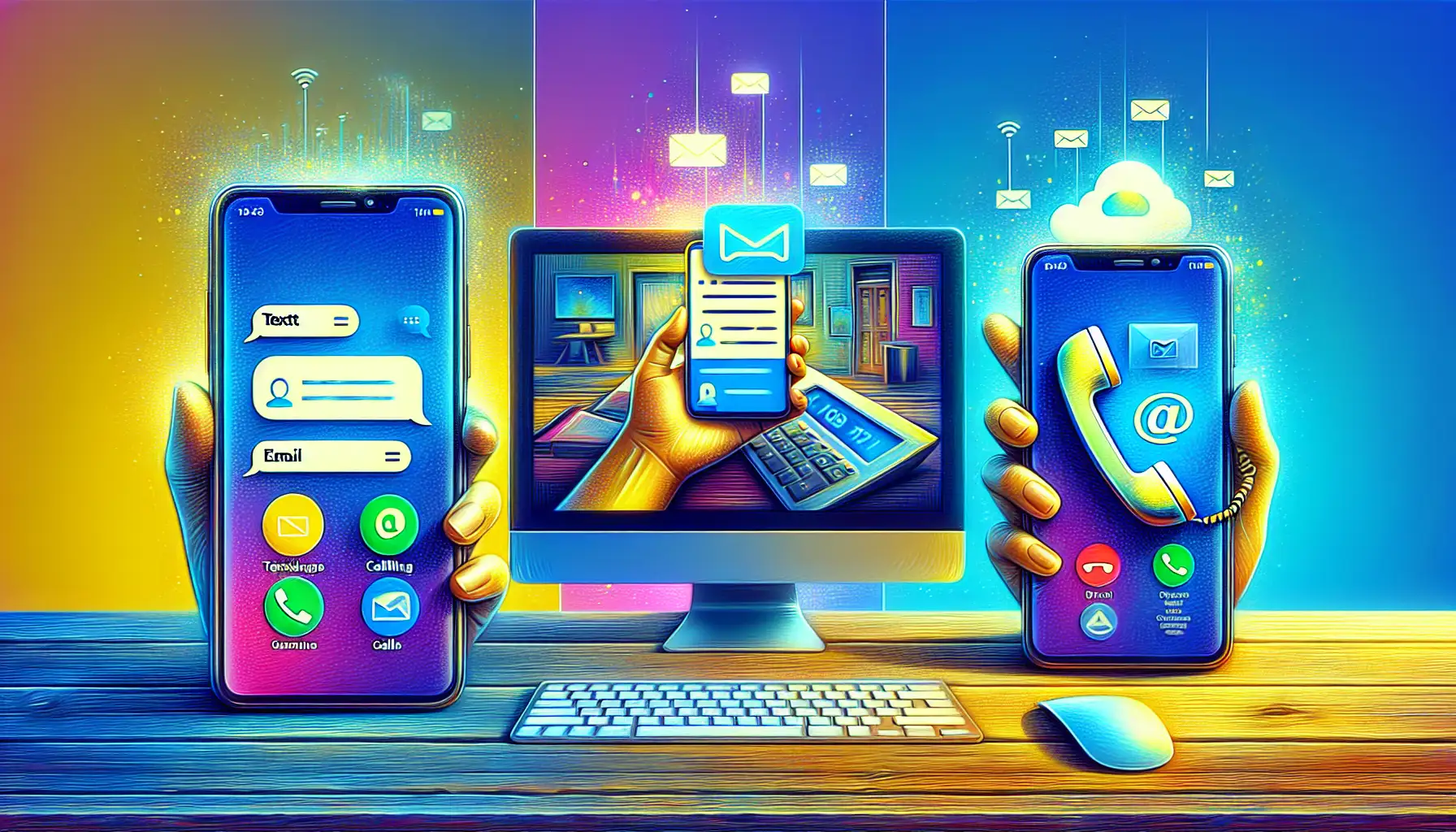Every business owner faces the same dilemma when it comes to customer communication: should I call, text, or email my customers? This question becomes even more critical when you’re trying to win new customers, provide exceptional service, or maintain long-term relationships. The choice between texting vs calling vs email isn’t just about personal preference—it’s about understanding what actually works in today’s fast-paced business environment.
Here’s a surprising statistic that might change how you think about customer communication: 89% of consumers prefer texting to calls or emails for business communication. However, this doesn’t mean you should abandon phone calls and emails entirely. The most successful businesses understand that each communication method has its place in the customer journey.
This comprehensive guide will compare all three communication methods, revealing their strengths, weaknesses, and optimal use cases. Moreover, you’ll discover how to combine texting, calling, and emailing strategically to maximize customer acquisition, improve satisfaction rates, and build stronger business relationships. By the end of this article, you’ll have a clear roadmap for choosing the right communication method for every customer interaction.
The compelling case for phone calls in customer communication
Phone calls remain one of the most personal forms of business communication available today. When comparing texting vs calling vs email, phone calls offer an immediacy and human connection that’s difficult to replicate through other channels. The ability to hear tone of voice, respond to questions in real-time, and build rapport makes phone calls incredibly powerful for certain business situations.
However, phone calls come with significant challenges in today’s communication landscape. They’re inherently intrusive, interrupting whatever your customer is doing at the moment you call. Furthermore, many customers actively avoid answering unknown numbers due to the prevalence of spam calls and telemarketing. Studies show that answer rates for business calls have dropped significantly, with some industries seeing answer rates as low as 15-20%.
When phone calls excel in business communication
Despite these challenges, phone calls shine in specific scenarios. Complex problem-solving conversations, detailed consultations, and high-value sales discussions often require the nuanced communication that only voice conversations can provide. Additionally, phone calls work exceptionally well for building trust with existing customers who already know your business.
The key to successful business calling lies in timing and permission. Rather than cold calling, consider using phone calls as a follow-up method after initial contact through other channels. This approach combines the personal touch of calling with the respect for customer preferences that modern business communication demands.
Understanding email’s role in modern customer communication
Email has been the backbone of business communication for decades, and for good reason. When evaluating texting vs calling vs email, email excels at delivering detailed information, maintaining professional records, and allowing customers to respond at their convenience. Email provides a permanent record of conversations, making it invaluable for complex transactions, detailed explanations, and formal business communications.
The major advantage of email lies in its ability to convey comprehensive information without time constraints. You can include attachments, detailed explanations, links to resources, and formatted content that enhances understanding. Email also allows customers to forward information to decision-makers, reference details later, and respond thoughtfully rather than immediately.
The challenges facing email communication today
Unfortunately, email faces significant hurdles in today’s communication environment. Open rates for business emails average around 20-25%, meaning three-quarters of your messages may never be seen. Response rates are even lower, often falling below 10% for many industries. The average person receives dozens of emails daily, making it easy for your message to get lost in crowded inboxes.
Spam filters present another challenge, sometimes blocking legitimate business emails from reaching customers. Additionally, email lacks the urgency and immediacy that many customer service situations require. While email remains essential for certain types of communication, relying solely on email for customer acquisition and engagement can limit your business growth.
Maximizing email effectiveness in your communication strategy
To make email work effectively in your communication mix, focus on timing, subject lines, and value proposition. Send emails when your audience is most likely to check their inbox, craft compelling subject lines that encourage opening, and ensure every email provides genuine value to the recipient. Consider segmenting your email lists to deliver more targeted, relevant content that resonates with specific customer groups.
Why SMS texting dominates customer communication preferences
Text messaging has emerged as the clear winner in the texting vs calling vs email debate for many types of customer communication. SMS boasts impressive statistics: 98% open rates, 90% of messages read within three minutes, and response rates that often exceed 45%. These numbers reflect a fundamental shift in how customers prefer to communicate with businesses.
The power of SMS lies in its simplicity and immediacy. Text messages are brief, direct, and designed for quick consumption. Customers can read and respond to texts without interrupting their daily activities, making SMS far less intrusive than phone calls while being more immediate than email. Moreover, text messaging feels personal and conversational, creating a more intimate connection between businesses and customers.
Why local service businesses thrive with SMS
Local service businesses particularly benefit from SMS communication. Whether you’re a plumber, electrician, restaurant, or retail store, text messaging allows you to connect with customers in your immediate geographic area quickly and effectively. You can send appointment reminders, share updates about service calls, notify customers about promotions, and handle simple customer service inquiries—all through the convenience of text messaging.
The mobile-first nature of modern life makes SMS even more powerful. Customers carry their phones everywhere, ensuring your messages reach them regardless of location. This accessibility, combined with the high engagement rates of SMS, makes texting an invaluable tool for customer acquisition and retention.
Best practices for business SMS communication
Successful SMS communication requires understanding the medium’s limitations and strengths. Keep messages concise and actionable, include clear next steps, and always provide value in every text. Timing matters significantly with SMS—avoid sending messages too early or late in the day, and consider your customers’ schedules when planning text campaigns.
Always obtain proper consent before sending business text messages, and make it easy for customers to opt out if they choose. Respect frequency preferences by avoiding message overload, and personalize your texts whenever possible to maintain the intimate feel that makes SMS so effective.
Texting vs calling vs email for customer acquisition success
When it comes to acquiring new customers, the choice between texting vs calling vs email can make or break your marketing efforts. Each method offers distinct advantages for different stages of the customer acquisition process, and understanding these differences is crucial for maximizing your conversion rates and building a sustainable customer base.
SMS excels at initial contact and engagement because of its high open rates and immediate visibility. When a potential customer provides their phone number, whether through a website form, in-store visit, or referral, a well-timed text message can capture their attention when they’re most interested in your services. The key is striking while the iron is hot—texting allows you to respond quickly to inquiries and maintain momentum in the sales process.
Speed and engagement advantages of SMS
The speed advantage of SMS cannot be overstated in customer acquisition. While emails might sit unread for hours or days, and phone calls might go unanswered, text messages are typically read within minutes. This immediacy allows you to respond to leads quickly, schedule appointments efficiently, and keep potential customers engaged throughout their decision-making process.
Furthermore, SMS creates a lower barrier to communication. Customers who might hesitate to answer a phone call from an unknown business number or respond to a lengthy email are often comfortable exchanging a few text messages. This comfort level makes SMS an excellent icebreaker that can lead to more substantial communication later in the relationship.
When to use phone calls for complex customer acquisition
Phone calls become essential when dealing with complex services, high-value transactions, or customers who need detailed explanations before making decisions. Industries like real estate, financial services, healthcare, and major home improvements often require the nuanced communication that only phone conversations can provide.
The key to successful phone-based customer acquisition is earning the right to call. Rather than cold calling, use initial SMS or email contact to introduce your business and request permission for a phone conversation. This approach respects customer preferences while positioning phone calls as valuable consultations rather than intrusive sales pitches.
Strategic timing and channel selection for maximum impact
The success of your customer communication strategy depends heavily on choosing the right channel at the right time. Understanding when to use texting vs calling vs email requires analyzing your customer’s journey, the complexity of your message, and the desired outcome of each interaction.
For immediate needs and simple communications, SMS reigns supreme. Appointment confirmations, quick updates, special offers, and basic customer service inquiries work best through text messaging. The instant nature of SMS makes it perfect for time-sensitive communications where you need quick acknowledgment or response from customers.
Email’s strategic role in relationship building
Email serves a crucial strategic function in nurturing long-term customer relationships. While it may not generate immediate responses like SMS, email excels at delivering valuable content, educational materials, and detailed information that helps customers make informed decisions. Use email for newsletters, detailed service explanations, follow-up resources, and maintaining contact with customers between active service periods.
The permanence of email makes it valuable for creating a communication history that customers can reference over time. This characteristic makes email essential for businesses that provide ongoing services or have long sales cycles where customers need time to consider their options.
Phone calls for relationship depth and problem resolution
Phone calls create the deepest level of personal connection and are irreplaceable for complex problem-solving situations. When customers have concerns, complaints, or need detailed consultations, phone calls allow you to address issues thoroughly and build stronger relationships through personal interaction.
Schedule phone calls strategically rather than using them for initial contact. Use SMS or email to set up phone appointments, ensuring customers are available and prepared for the conversation. This approach increases answer rates and creates more productive conversations.
Industry-specific communication preferences and strategies
Different industries see varying levels of success with texting vs calling vs email, and understanding these industry-specific preferences can significantly improve your communication effectiveness. Local service businesses, retail establishments, healthcare providers, and professional services each have unique communication needs that favor different channels.
Restaurants and retail businesses often find SMS most effective for promotions, order updates, and customer engagement. The immediate nature of text messaging aligns perfectly with the fast-paced decisions customers make about dining and shopping. However, these businesses still rely on email for detailed newsletters and phone calls for complex catering or special event coordination.
Healthcare and professional services communication needs
Healthcare providers must balance efficiency with privacy and compliance requirements. SMS works excellently for appointment reminders and basic updates, while phone calls remain essential for discussing medical concerns and providing personalized care. Email serves important functions for sharing educational resources and maintaining patient communication records.
Professional services like accounting, legal, and consulting firms often require all three communication methods. Initial contact might happen through SMS or email, detailed consultations occur via phone calls, and ongoing project updates and documentation flow through email systems.
Adapting communication strategies by demographic
Customer demographics significantly influence communication preferences. Younger customers typically prefer SMS and email, while older customers may be more comfortable with phone calls. However, these preferences continue evolving as technology adoption spreads across all age groups.
Consider offering multiple communication options and allowing customers to specify their preferences. This customer-centric approach ensures you’re communicating through channels that customers actually want to use, improving response rates and satisfaction levels across all demographic groups.
How to combine texting, calling, and email effectively
The most successful businesses don’t choose between texting vs calling vs email—they integrate all three methods into a cohesive communication strategy. This multi-channel approach maximizes the strengths of each method while minimizing their individual weaknesses, creating a comprehensive system that serves customers better and drives superior business results.
Start with SMS for first contact because of its high visibility and engagement rates. When a potential customer expresses interest in your services, a prompt, friendly text message can capture their attention and begin the relationship on a positive note. Use this initial text to introduce your business, confirm their interest, and set expectations for follow-up communication.
Creating a systematic communication flow
Develop a systematic approach that moves customers through different communication channels based on their needs and the complexity of their requests. Begin with SMS for immediate acknowledgment and basic information gathering. Progress to phone calls when detailed discussions become necessary, and use email to document important information and provide resources for future reference.
For example, when a customer texts about needing plumbing services, respond immediately via SMS to acknowledge their request and gather basic information. Schedule a phone call to discuss the problem in detail and provide an estimate. Follow up with an email confirming the appointment details, pricing, and any preparation instructions.
Maintaining consistency across all channels
Ensure your brand voice and messaging remain consistent across SMS, phone calls, and email communications. Customers should receive the same level of professionalism and service quality regardless of which channel they use to contact your business. Train your team to seamlessly transition between communication methods while maintaining relationship continuity.
Document customer preferences and communication history across all channels. This documentation ensures that every team member can provide informed, personalized service regardless of how the customer chooses to communicate. Consider using customer relationship management (CRM) systems that integrate SMS, email, and call logging for comprehensive communication tracking.
Common mistakes to avoid in multi-channel communication
Even businesses that understand the importance of combining texting vs calling vs email often make critical mistakes that undermine their communication effectiveness. Avoiding these common pitfalls can significantly improve your customer relationships and business outcomes.
One of the most frequent mistakes is overwhelming customers with too much communication across multiple channels. Sending a text message, leaving a voicemail, and sending an email about the same topic within a short timeframe can frustrate customers and make your business appear disorganized. Instead, choose the most appropriate channel for each message and allow reasonable time for responses before following up through different methods.
Timing and frequency considerations
Poor timing across communication channels can damage customer relationships. Sending text messages too early or late in the day, making phone calls during busy periods, or flooding email inboxes with frequent messages can create negative impressions. Research your target audience’s preferences and establish communication schedules that respect their time and attention.
Establish clear internal protocols about communication frequency and timing. Create guidelines that prevent multiple team members from contacting the same customer through different channels simultaneously. This coordination ensures customers receive consistent, well-timed communication that enhances rather than hinders their experience with your business.
Failing to track and measure communication effectiveness
Many businesses use multiple communication channels without measuring their effectiveness or optimizing their approach based on results. Track response rates, conversion rates, and customer satisfaction across SMS, phone calls, and email to identify which methods work best for different types of communications and customer segments.
Use this data to refine your communication strategy continuously. If SMS generates better response rates for appointment confirmations, prioritize texting for those communications. If phone calls lead to higher conversion rates for complex services, invest more time in phone-based consultations. Data-driven communication strategies consistently outperform approaches based on assumptions or preferences alone.
Technology tools and automation for streamlined communication
Modern technology offers powerful solutions for managing texting vs calling vs email communications efficiently and effectively. Automation tools can handle routine communications, ensure timely follow-ups, and maintain consistent customer contact without overwhelming your team with manual tasks.
Customer communication platforms that integrate SMS, email, and call management provide centralized control over all customer interactions. These systems can automatically send appointment reminders via text, follow up with detailed emails, and schedule phone calls based on customer preferences and business rules you establish.
Automation best practices for customer communication
Implement automation strategically to enhance rather than replace human interaction. Use automated systems for routine tasks like appointment confirmations, basic follow-ups, and information delivery, while reserving personal communication for complex issues, relationship building, and problem resolution.
Ensure automated messages maintain your brand voice and provide genuine value to customers. Poorly written automated texts or emails can damage your business reputation and reduce customer satisfaction. Regularly review and update automated communications to ensure they remain relevant, helpful, and professionally crafted.
Integration strategies for seamless communication
Choose communication tools that integrate with your existing business systems, including scheduling software, customer databases, and billing systems. This integration ensures that customer communication remains synchronized with your business operations and provides team members with complete customer information regardless of which communication channel they’re using.
Consider platforms like The Customer Robot that specialize in automating SMS communication while maintaining integration capabilities with other business tools. These specialized solutions often provide better functionality and results than generic communication platforms that try to handle every type of business communication without specialization.
The debate between texting vs calling vs email doesn’t have a single winner—it has a strategic solution that combines all three methods effectively. SMS wins for customer acquisition and immediate engagement due to its exceptional open rates and quick response times. Phone calls excel when detailed discussions, complex problem-solving, or personal relationship building becomes necessary. Email serves as the foundation for documentation, detailed information sharing, and long-term customer relationship maintenance.
The businesses that achieve the greatest success in customer communication are those that master all three channels and use them strategically throughout the customer journey. They understand that modern customers expect flexibility in how they communicate with businesses, and they provide multiple options while guiding customers toward the most effective channel for each type of interaction.
Start implementing this integrated approach by using SMS for initial customer contact and quick communications, transitioning to phone calls when conversations require depth and nuance, and following up with email documentation and resources. This systematic approach respects customer preferences while maximizing the unique strengths of each communication method.
The businesses that master all three communication channels will win the most customers, build stronger relationships, and achieve superior results in today’s competitive marketplace. Don’t limit yourself to a single communication method when you can leverage the combined power of texting, calling, and emailing to transform your customer relationships and drive business growth.
Ready to revolutionize your customer communication strategy? Consider using The Customer Robot to automate your SMS communications and create seamless integration between texting, calling, and email. This specialized platform can help you implement the multi-channel communication strategy outlined in this guide, ensuring you connect with customers through their preferred methods while maintaining the efficiency and consistency your business needs to thrive.






